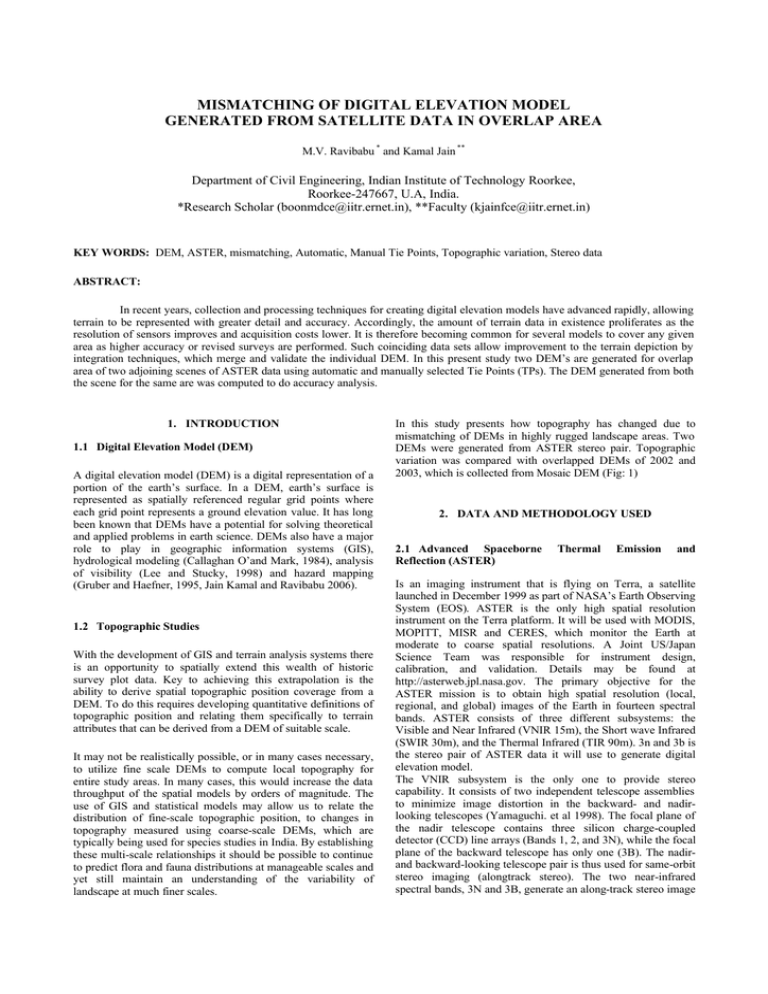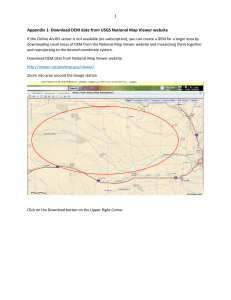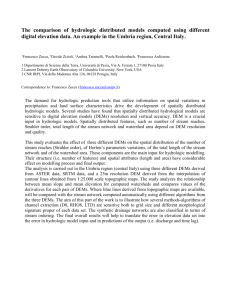MISMATCHING OF DIGITAL ELEVATION MODEL
advertisement

MISMATCHING OF DIGITAL ELEVATION MODEL GENERATED FROM SATELLITE DATA IN OVERLAP AREA M.V. Ravibabu * and Kamal Jain ** Department of Civil Engineering, Indian Institute of Technology Roorkee, Roorkee-247667, U.A, India. *Research Scholar (boonmdce@iitr.ernet.in), **Faculty (kjainfce@iitr.ernet.in) KEY WORDS: DEM, ASTER, mismatching, Automatic, Manual Tie Points, Topographic variation, Stereo data ABSTRACT: In recent years, collection and processing techniques for creating digital elevation models have advanced rapidly, allowing terrain to be represented with greater detail and accuracy. Accordingly, the amount of terrain data in existence proliferates as the resolution of sensors improves and acquisition costs lower. It is therefore becoming common for several models to cover any given area as higher accuracy or revised surveys are performed. Such coinciding data sets allow improvement to the terrain depiction by integration techniques, which merge and validate the individual DEM. In this present study two DEM’s are generated for overlap area of two adjoining scenes of ASTER data using automatic and manually selected Tie Points (TPs). The DEM generated from both the scene for the same are was computed to do accuracy analysis. 1. INTRODUCTION 1.1 Digital Elevation Model (DEM) A digital elevation model (DEM) is a digital representation of a portion of the earth’s surface. In a DEM, earth’s surface is represented as spatially referenced regular grid points where each grid point represents a ground elevation value. It has long been known that DEMs have a potential for solving theoretical and applied problems in earth science. DEMs also have a major role to play in geographic information systems (GIS), hydrological modeling (Callaghan O’and Mark, 1984), analysis of visibility (Lee and Stucky, 1998) and hazard mapping (Gruber and Haefner, 1995, Jain Kamal and Ravibabu 2006). 1.2 Topographic Studies With the development of GIS and terrain analysis systems there is an opportunity to spatially extend this wealth of historic survey plot data. Key to achieving this extrapolation is the ability to derive spatial topographic position coverage from a DEM. To do this requires developing quantitative definitions of topographic position and relating them specifically to terrain attributes that can be derived from a DEM of suitable scale. It may not be realistically possible, or in many cases necessary, to utilize fine scale DEMs to compute local topography for entire study areas. In many cases, this would increase the data throughput of the spatial models by orders of magnitude. The use of GIS and statistical models may allow us to relate the distribution of fine-scale topographic position, to changes in topography measured using coarse-scale DEMs, which are typically being used for species studies in India. By establishing these multi-scale relationships it should be possible to continue to predict flora and fauna distributions at manageable scales and yet still maintain an understanding of the variability of landscape at much finer scales. In this study presents how topography has changed due to mismatching of DEMs in highly rugged landscape areas. Two DEMs were generated from ASTER stereo pair. Topographic variation was compared with overlapped DEMs of 2002 and 2003, which is collected from Mosaic DEM (Fig: 1) 2. DATA AND METHODOLOGY USED 2.1 Advanced Spaceborne Reflection (ASTER) Thermal Emission and Is an imaging instrument that is flying on Terra, a satellite launched in December 1999 as part of NASA’s Earth Observing System (EOS). ASTER is the only high spatial resolution instrument on the Terra platform. It will be used with MODIS, MOPITT, MISR and CERES, which monitor the Earth at moderate to coarse spatial resolutions. A Joint US/Japan Science Team was responsible for instrument design, calibration, and validation. Details may be found at http://asterweb.jpl.nasa.gov. The primary objective for the ASTER mission is to obtain high spatial resolution (local, regional, and global) images of the Earth in fourteen spectral bands. ASTER consists of three different subsystems: the Visible and Near Infrared (VNIR 15m), the Short wave Infrared (SWIR 30m), and the Thermal Infrared (TIR 90m). 3n and 3b is the stereo pair of ASTER data it will use to generate digital elevation model. The VNIR subsystem is the only one to provide stereo capability. It consists of two independent telescope assemblies to minimize image distortion in the backward- and nadirlooking telescopes (Yamaguchi. et al 1998). The focal plane of the nadir telescope contains three silicon charge-coupled detector (CCD) line arrays (Bands 1, 2, and 3N), while the focal plane of the backward telescope has only one (3B). The nadirand backward-looking telescope pair is thus used for same-orbit stereo imaging (alongtrack stereo). The two near-infrared spectral bands, 3N and 3B, generate an along-track stereo image pair with a base-to-height (B/H) ratio of about 0.6 and an intersection angle of about 27.70 (Fig. 1). Since the two telescopes can be rotated 240 to provide extensive cross-track pointing capability and five-day revisit capability, across-track stereo imaging with a better B/H ratio (close from one) is also possible. These subset areas were selected (from both DEMs) from the overlap area (fig.1). The digital elevation model (DEM) from satellite data has been a vibrant research and development topic for the last 30years since the launch of the first civilian remote sensing satellite. Stereo-viewing of images was and still is the most common method used by the mapping, photogrammetry, and remote sensing communities for elevation modeling. To obtain stereoscopy with images from satellite scanners, two solutions are possible: 1) along-track stereoscopy from the same orbit using fore and aft images. 2) across-track stereoscopy from two different orbits. 2.2 Study Area and Methodology DEM was generated from ASTER L1B data first scene is acquired in 2002 and second scene 2005 of same area of Dehradun. Maximum elevation in this area approximately 700m from msl. DEMs are generated from manually collected tie points and automatically collecting GCPs from above scenes. For analysis purpose selected some portion from the image. Subset area is contains various topography like flat area to hilly area. DEM-2002 Figure 2. DEM generated from ASTER –year 2002 DEM-2005 Overlap area of Mosaic Figure 1. Diagram showing the study area of overlap site in Mosaic image Figure 2a. Profile of DEM-2002 (Gray Values shows Height information) For DEM extraction only the VNIR nadir and backward images (3N and 3B) are used. The geometric model being used is a rigorous one; it reflects the physical reality of the complete viewing geometry and corrects distortions that occur in the imaging process due to platform, sensor, earth, and cartographic projection conditions. After rigorous models (collinearity and coplanarity equations) are computed for the 3N and 3B images, a pair of quasi-epipolar images is generated from the images in order to retain elevation parallax in only one direction. An automated image-matching procedure is used to generate the DEM through a comparison of the respective gray. Firstly DEM was generated by automatic procedure. Automatic generated DEM gives some black spots in the image may be because of cloud and shadow. In some area black spots were found because of mismatch of features. Mitsuharu Tokunaga and Seiich Harasame (1996) has observed same errors in their study. To minimize of these block spots (errors) some more tie points (TPs) were added in both images by manually (3N, 3B). Then DEM was generated with already existing GCPs and TPs. DEMs were generated from above methodology for both 2002 image and 2005 image. Common area was selected for analyses purpose Fig 2, 2a and 3, 3a show the DEM-2002 and DEM2005 and their profiles (Fig 2a, 3a) along line respectively. Figure 3. DEM generated from ASTER –year 2005 680 660 640 620 600 580 560 540 520 500 480 460 440 420 400 380 360 340 320 300 DEM-2002 DEM-2005 M O S IO C 6 4 46 4 1 6 2 6 5 7 7 5 8 25 8 2 562 5 4 2 5 4 5 528 4 8 9 4 6 8 4 5 8 4 5 0 452 443 437 4 4 8 435 422 3 8 5 360 3 5 1 3 5 2 3 4 3 333 Figure 3a. Profile of DEM-2005 (Gray Values shows Height information) HORIZONTAL VALUES 3. RESULTS AND DISCUSSIONS Figure 6. Minimum and Maximum height of control points between DEM-2002, DEM-2005 and Mosaic. 26 common points were collected from both DEMs and Mosaic DEM. Topographic variation between DEM-2002 and DEM2005 has shown in fig.4. Generated slope from both DEMs (fig.5) and maximum vitiation shows more than >400 slope which is very high rugged topography of study area. Height variation to the order of 15-22m is observed on the CP selected in the overlap area. Therefore it is the concluded that proper care should be taken in preparing mosaic. DEM-2005 REFERENCES 78 .09 30 78 8 .1 78 124 .14 78 297 .13 78 326 .15 78 999 .15 78 983 .14 78 195 .07 78 435 .08 78 738 .13 78 878 .08 78 728 .10 78 598 .15 78 115 .09 40 8 7 78 8.10 .11 4 3 78 61 .13 78 256 .08 78 577 .13 78 767 .14 78 973 .14 29 78 3 .1 78 033 .10 39 1 Verical Distance (Z) DEM-2002 680 660 640 620 600 580 560 540 520 500 480 460 440 420 400 380 360 340 320 300 Callaghan O’, J.F., Mark, D.M., 1984. The extraction of drainage networks from digital elevation data. Computer Vision, Graphics and Image Processing 28 (3), 323– 344. Horizontal Distance Figure 4. Minimum and Maximum height of control points in DEM-2002 and DEM-2005 60 50 40 DEM-2005 30 DEM-2002 Gruber, U., Haefner, H., 1995. Avalanche hazard mapping with satellite data and a digital elevation model. Applied Geography 15 (2), 99– 113. Jain Kamal and Ravibabu, M.V., 2006, Identification of landslide Zonation using aster generated digital elevation model, The Indian Journal of Institution Surveyor (IJIS) Vol: 60, No: 1, pp 58-61 20 10 0 0-10 11-20% 21-30 31-40 41-50 51-60 61-70 >70 Slope (%) Figure 5. Shows that number of pixels falls in to different slops like 0o-10o,11o-20o,21o-30o,31o-40o,41o-50,51o-60o and >700 Topography of DEM-2002 and DEM-2005 was compared with after mosaic of both DEMs these variation can be shows in fig 6. comparing with mosaic DEM very high elevation portion (green circle) is not matching with above both DEMs. In some areas (where steep drainage pattern exist) also not matched with mosaic DEMs (red circle in fig.6) because of mismatching of DEMs in overlapped area Lee, J., Stucky, D., 1998. On applying viewshed analysis fro determining least-cost paths on digital elevation model. International Journal of Geographical Information Science 12 (8), 891– 905. Mitsuharu Tokunaga and Seiich Harasame, 1996, DEM Accuracy Derived from ASTER Data, Proceeding of ACRS Smith, J., 2000. Remote sensing to predict volcano outbursts. In: The International Archives of the Photogrammetry, Remote Sensing and Spatial Information Sciences, Kyoto, Japan, Vol. XXVII, Part B1, pp. 456-469. Yamaguchi. Y, A. Kahle, H. Tsu, T. Kawakami, and M. Pniel, Overview of advanced spaceborne thermal emission and reflection radiometer (ASTER), IEEE Trans. Geosci. Remote Sensing, vol. 36, pp. 1062–1071, July 1998.





